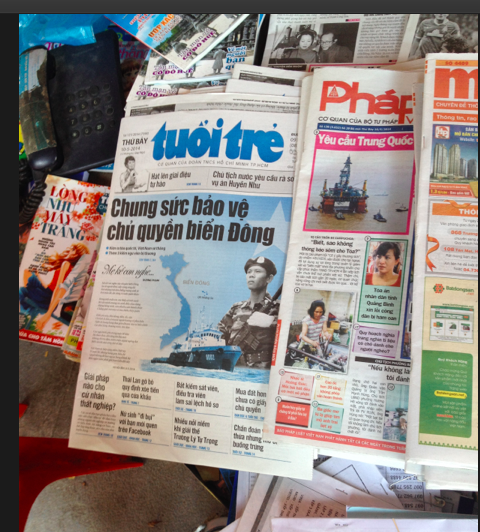
By Rachel Brown
As members of the trip discussed our experiences in Hanoi and Ho Chi Minh City, I often found myself trying to look at Vietnam through the lens of China. It wasn’t just the traditional Chinese characters engraved on temple gates throughout Hanoi that sparked comparisons between the two nations, but also political and economic systems that appeared, at least on the surface, quite similar. Communist parties who came to power after a civil war rule both nations. In both nations, the rule of the Communist party has now been blended with a system with market capitalism fueled by opening the economy to foreign investment and manufacturing. Both Vietnam and China continue to struggle with what it means to attempt to blend one-party rule with the principles of a free market.
Considering the geographic proximity of Vietnam and China, comparisons are perhaps inevitable. In the media, both countries have been characterized as “rising dragons” partially because of consistently high economic growth rates. Vietnam’s economic reforms instituted under the doi moi policy in 1986 and it was in many ways similar to China’s policy of “Reform and Opening,” during the late 1970s and early 1980s. Like China did in the early stages of Reform and Opening, Vietnam has welcomed factories owned by foreign companies and has become a major producer of textiles and shoes, among other products. In fact some of the factories now in Vietnam relocated from China in search of ever-lower labor costs. Many of the workers in factories in Vietnamese provinces such as Binh Duong and Dong Nai, are young women who have migrated to urban areas from rural provinces. This pattern is similar to what has occurred in China where massive internal migration has provided the labor force for Chinese factories in Guangdong or Shenzhen. In China, the hu kou system, a household registration system that limits migrants’ access to social services outside the province in which they are registered, has a significant impact on migrants’ lives. While in Vietnam, internal migrants face restrictions under the similarly named ho khao system.

Linguistic similarities with Mandarin Chinese appear elsewhere in the Vietnamese language as well. One afternoon, attempting to order lunch despite our woeful lack of Vietnamese, a few of us resorted to guessing what dishes might be listed on the menu by guessing at possible cognates with Chinese While, admittedly a highly imperfect technique, we were pleased to discover that Vietnamese miến were indeed noodles as a comparison with the Chinese word mian had suggested, and that dishes identified as xào were stir-fried just like dishes labeled with chao are in China. Many of these linguistic and cultural traces are remnants of China’s colonization of what is now Vietnam during the first millennia A.D. through 1010 A.D. when the Ly Dynasty gained independence for Vietnam.
While such comparisons are tempting (and maybe even a bit useful when trying to order), they seem particularly odd at a moment when tensions between China and Vietnam are high. Moreover, trying to impose the framework of China’s development to modern-day Vietnam, excludes much of the nuance of Vietnam’s distint cultural identity and its own development and present policy, as well as its distinctive cultural identity. For example, while Vietnam restricts freedom for the press, its internet and media censorship are weaker than China’s “great firewall.”
The new friction in the Sino-Vietnam relationship, arising from China’s decision to move an oil rig into disputed waters in the South China Sea (or East Sea as it is referred to here), also reflects a key way in which Vietnam and China differ. Vietnam is a small state adjacent to a large and increasingly powerful China. While the difference in scale between China and Vietnam’s population and geography is obvious, it also has important implications for attempted comparisons between the two nations. Suggestions that Vietnam will follow along China’s economic trajectory and make similar policy choices, neglect the fact that as a smaller state Vietnam will face a different array of challenges and have different resources to draw on than China does. Moreover, the small state-large state difference also alters the ways in which the two nations approach their foreign policies. Vietnam has to act with the constant awareness of what its large and ambitious next-door neighbor might do. China, the largest state in the region, faces no such constraint. In some ways, this means that Vietnam has to be more creative with its policy choices in order to fight for national interests and continue to increase its international stature despite its smaller size. In this respect, Vietnam might be better compared to states such as Taiwan or Singapore. While it is tempting to see Vietnam as a “mini China,” recent tensions suggest that Vietnam may be searching for other role models as well.